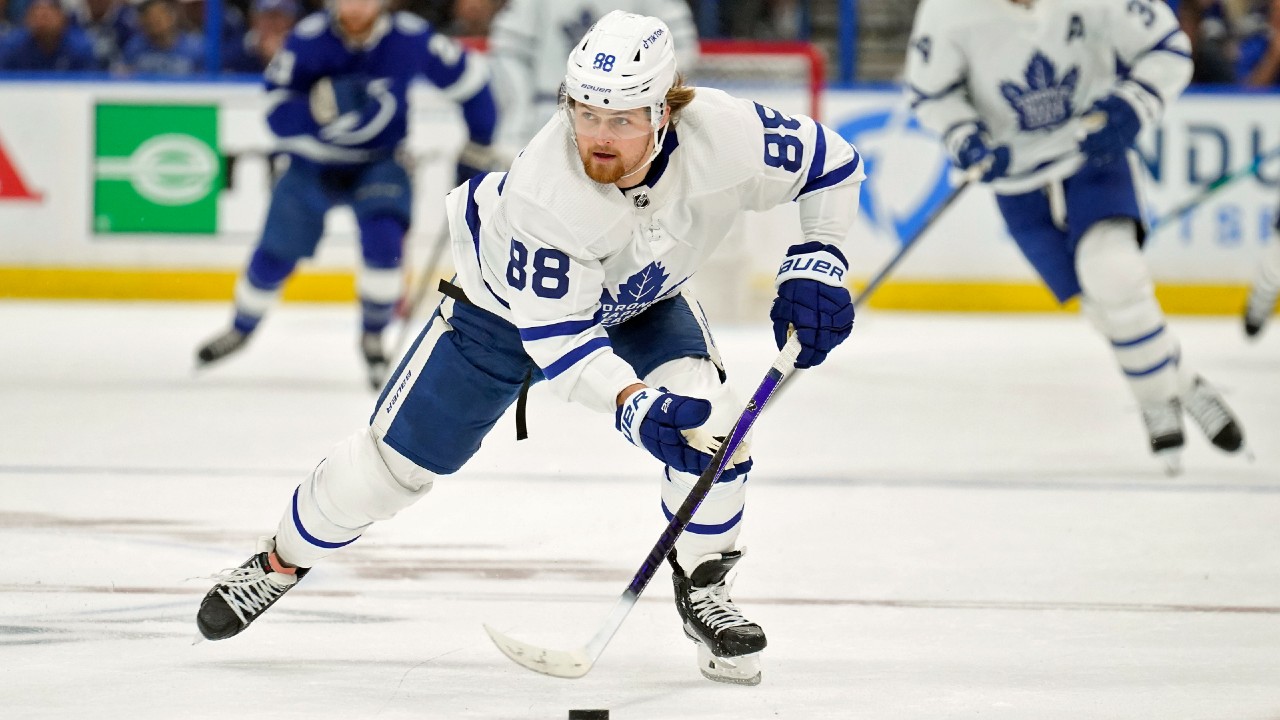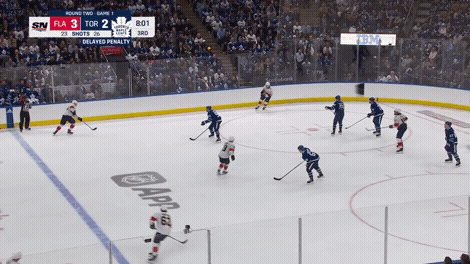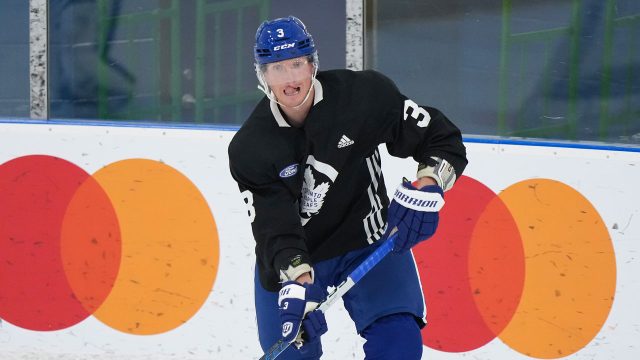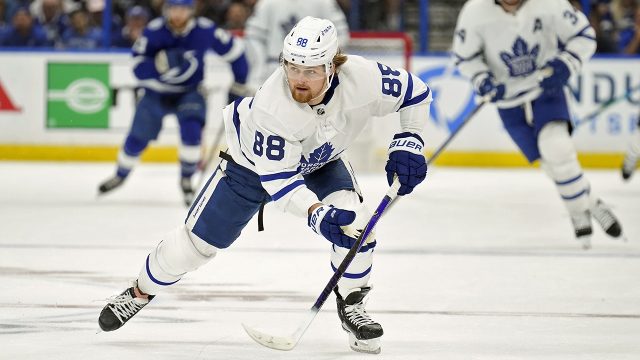
After the Maple Leafs finally got past Round 1 in the spring, only to quickly be dismissed in Round 2, many believed the summer of 2023 would be the end of the Core Four, and that some level of change was inevitable.
Rather, the biggest change happened off the ice, where a new shot caller was hired in the front office. New GM Brad Treliving decided to keep the core and add around it.
But there is one interesting change being made to the Core Four that we’re intently watching play out this pre-season. Head coach Sheldon Keefe, himself extended with a new contract, said right out of the gate that Nylander would open camp as a centre and that it wasn’t going to be a one-off thing.
“It’s something we haven’t given a whole lot of runway with and we’ll commit to it for a bit here,” Keefe said. “Not committing to any specific period of time, but just to say it’s not going to be a one-off or one-day or one-pre-season-game thing.”
What this does to the rest of the lineup remains to be seen. The Leafs could run with a trio of centres of Auston Matthews, John Tavares and Nylander to spread out their weapons. They could even decide to eventually move Tavares to the wing.
Nylander’s first pre-season game at centre ended without a point, but with him winning 50 per cent of his draws in a road loss to Ottawa. Nylander played with Max Domi, which could be a combination the Leafs move forward with.
So, will this be a good move for the Leafs, or not? For this, we turn to our experts Justin Bourne and Jason Bukala, who share what they think the pros and cons are of moving Nylander to the middle.
THE PROS
Bukala: Nylander will now have the flexibility to use the entire width of the ice on zone exits and he’s a fantastic skater who can take advantage of that extra space. He’s quick out of the blocks, which should lead to early separation from opponents and make life difficult on the backcheckers from the other team.
My only concern is whether or not his read/react game will be affected to the point he doesn’t properly time how he finds space to pounce on pucks in open ice. If he does time it well, once he’s up to full speed, he has potential to be even more dangerous offensively.
In the following clip, Nylander is the second forward on the backcheck. John Tavares wins a puck above the hash marks in the Leafs’ zone and chips it into the neutral zone. Nylander’s pace and skill take over from that point.
Almost all NHL teams employ a backchecking strategy that asks the first forward to pressure the puck. Tavares could easily have been a winger in this clip instead of the centre. If Nylander is late on his offensive zone exit, he will have support from his linemates. He should still have opportunities to win races for pucks in the neutral zone and provide offence.
Bourne: Playing centre would give Nylander more touches out of the middle of the ice, which is great for a few reasons. For one, he makes people miss with the best of them, and being able to go either way on defenders — neutralizing their ability to angle him — will help Nylander get to better offensive spots with more space. When Nylander goes cold, he gets stuck on the outside (by settling for the open ice the defence suggests to him), which makes me think this change could shorten his intermittent snaps of unproductive play.
Also, if Nylander is going to play centre, it’s possible he’d be a third-liner (despite being a better player than Tavares at this point of their careers). That happens if you do something like put Tavares and Marner together, Matthews with Tyler Bertuzzi, and suddenly the opposition has to show Nylander their third-best line. Considering he’s a first-line NHL talent, in theory he should be able to feast in those matchups, or at least win them handily.
THE CONS
Bukala: Nylander’s defensive detail has always varied for me. Thinking back to his development years in Europe before he was selected by the Leafs eighth overall in 2014, he played centre on the big international ice and was always in motion. He rarely stopped on pucks deep in his zone. He was an area defender with a generally active stick.
I believe we will see much of the same this season from Nylander if the Leafs decide to roll him out as a centre for the whole thing. There are going to be some frustrating moments. It’s going to come down to his buy-in to all three zones. His reads are going to have to be better timed and he’s going to need a more consistent effort when tracking back the full length of the ice to help down low in his own zone.
Here’s an example of how Nylander can frustrate defensively at times:
He failed to keep the puck in on the offensive blue line. He looked engaged on the backcheck, but his effort to knock the puck off his opponent high in the Leafs’ zone was far too light. He ends up turning his back on the play, floats out toward his blue line, and finally re-enters the clip coasting through the slot as he watches the puck enter Toronto’s net.
Bourne: Centres tend to defend in the D-zone and, as Jason notes, that is not a strength of Nylander’s. Go ahead and throw out all the caveats: Nylander outscores his shortcomings; he was the Leafs’ most effective forward against Florida in the playoffs when they were chasing games; other players make D-zone mistakes too; and … and … and.
He’s very good! But, again, there are moments like this where he defends low in the playoffs and doesn’t make one physical move to battle for body position or clear the area in front of his goalie.
Those moments simply will happen from time to time if he’s the low guy defending. And so, “D-zone coverage” falls clearly in the “cons” category.
Having Nylander at centre is also going to be a lot more work for his wingers. When presented with 50/50 decisions (Should I go here and maybe get a breakaway, but get burned the other way if it doesn’t work?) you want Nylander to take those chances because his ability to do damage offensively is worth some of the risk. But that also means he’s often the last forward to leave the O-zone and come back to his own, meaning his wingers will have to be F3s and get back first to play low.
This means that sometimes Nylander’s wingers will have to make more conservative decisions and, at times, even come back to play low when they’re level on the back-check and sorting out D-zone roles. (If Nylander plays with a defensively stout winger, it could be assumed that player would play low when they’re coming back and level, so that could be a solution there.)
PRO OR CON: WAIT AND SEE
Bukala: It’s important for teams to start with the puck in all three zones, and so NHL coaches are always running set plays off faceoffs. They have strategies in place for when a draw is won or lost. It’s going to be interesting to see how Nylander establishes himself in the faceoff circle.
Nylander’s success rate, in the past, has fluctuated. It appears when he has more of an opportunity to take draws, his winning percentage drastically increases. In seasons when he hasn’t been tasked to take face-offs, he didn’t seem comfortable doing it and never got in a groove. The more draws he takes, the better he is.
Since 2016, Nylander has a cumulative faceoff winning percentage of 45 in seasons he’s had fewer than 125 draws, and that success rate increases to 53 per cent in seasons when he’s seen over 125 faceoffs.
|
SEASON |
FACEOFF WINS |
FACEOFF LOSSES |
FACEOFF % |
|
2016-17 |
49 |
73 |
40.2 |
|
2017-18 |
334 |
316 |
51.4 |
|
2018-19 |
203 |
165 |
55.2 |
|
2019-20 |
106 |
106 |
50 |
|
2020-21 |
13 |
10 |
56.5 |
|
2021-22 |
34 |
31 |
52.3 |
|
2022-23 |
25 |
34 |
31.6 |
Assuming Nylander plays the entire season at centre, it’s safe to forecast him taking over 600 faceoffs this season. That difference of eight per cent amounts to the Leafs having the puck around 48 more (or less) times than their opponents. It’s not clear if we should expect his faceoff ability to be a pro or a con yet — it could go either way.
CONCLUSION
Bukala: If Nylander proves he is capable of playing centre with average-plus detail in all three zones and continues to score at a high rate, his leverage in contract talks next off-season will increase exponentially.
In my opinion, Nylander’s next contract is likely to land in the same range as Johnny Gaudreau’s ($9.75 million AAV), or Jonathan Huberdeau’s ($10.5 million AAV) if he played the wing.
Proving he is a potential 1C or 2C, however, will increase his value on the open market. In that case, he’d likely be staring north of $11 million per year if he were to go to free agency next July.
Bourne: My gut is they’ll give Nylander lots of runway in the regular season, and maybe even stick with it all the way up to the trade deadline. He played centre while I was on staff with the Toronto Marlies, and he can do it (his skating and strength leave no doubt). I say they try this until the trade deadline, because determining whether he can play both centre and wing would open up who the Leafs could then add. At that point, they may say, “We think we can use him there, but can we add a true third-line centre and use Nylander with some of our better players farther up the lineup?”
If they keep him at centre all season, they’re committing to using him there in the playoffs too, and I feel like that would make the Leafs a little nervous.
But what’s so great is that this challenge asks the very fair questions of “What are you?” and “Can you drive a line?” as they try to figure out Nylander’s value and consider his next contract or, potentially, trade. If Nylander can drive a line and keep scoring at centre, he’ll be worth more than if he were just a winger, as Bukala suggests.
If Nylander can’t do that and instead shows himself to be a complementary guy, the Leafs may gain leverage of their own. In the end, I think it’ll work and that they’ll keep him there for the bulk of the season. But I bet, come playoff time, Nylander will play less than 50 per cent of his minutes as a centre.








